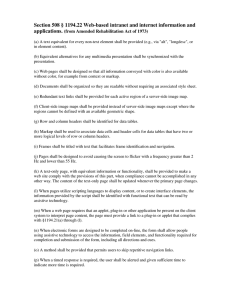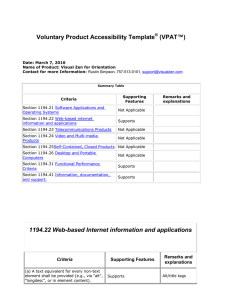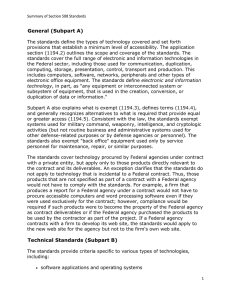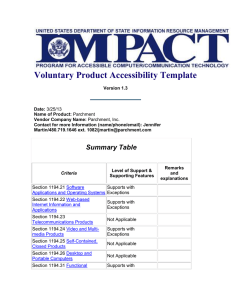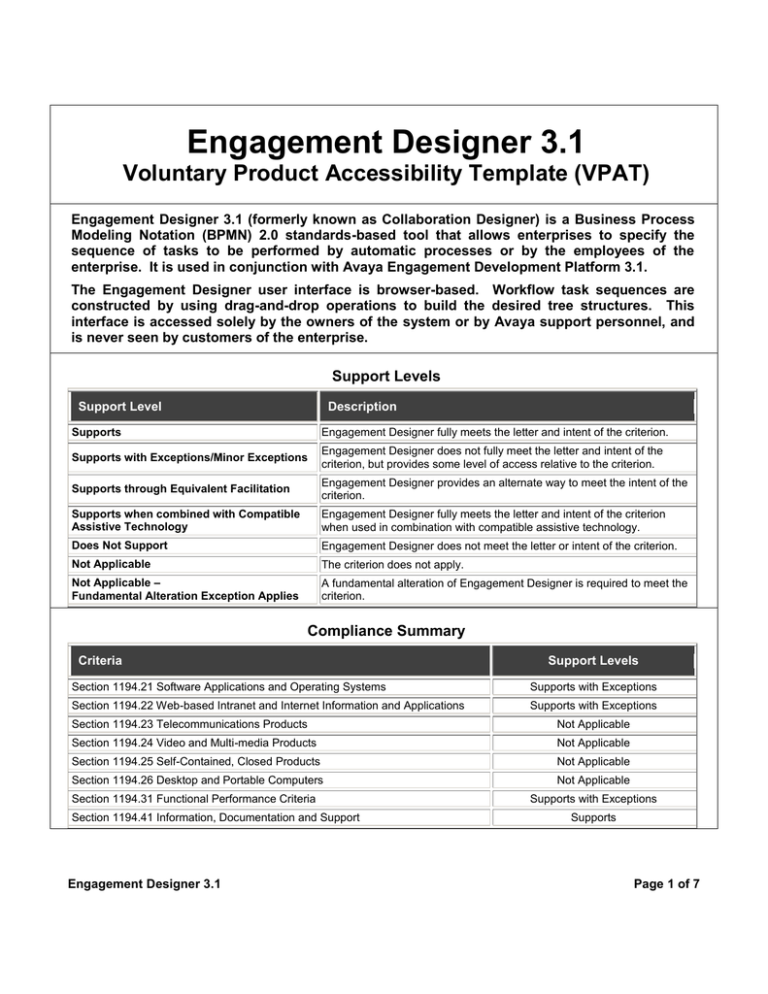
Engagement Designer 3.1
Voluntary Product Accessibility Template (VPAT)
Engagement Designer 3.1 (formerly known as Collaboration Designer) is a Business Process
Modeling Notation (BPMN) 2.0 standards-based tool that allows enterprises to specify the
sequence of tasks to be performed by automatic processes or by the employees of the
enterprise. It is used in conjunction with Avaya Engagement Development Platform 3.1.
The Engagement Designer user interface is browser-based. Workflow task sequences are
constructed by using drag-and-drop operations to build the desired tree structures. This
interface is accessed solely by the owners of the system or by Avaya support personnel, and
is never seen by customers of the enterprise.
Support Levels
Support Level
Description
Supports
Engagement Designer fully meets the letter and intent of the criterion.
Supports with Exceptions/Minor Exceptions
Engagement Designer does not fully meet the letter and intent of the
criterion, but provides some level of access relative to the criterion.
Supports through Equivalent Facilitation
Engagement Designer provides an alternate way to meet the intent of the
criterion.
Supports when combined with Compatible
Assistive Technology
Engagement Designer fully meets the letter and intent of the criterion
when used in combination with compatible assistive technology.
Does Not Support
Engagement Designer does not meet the letter or intent of the criterion.
Not Applicable
The criterion does not apply.
Not Applicable –
Fundamental Alteration Exception Applies
A fundamental alteration of Engagement Designer is required to meet the
criterion.
Compliance Summary
Criteria
Support Levels
Section 1194.21 Software Applications and Operating Systems
Supports with Exceptions
Section 1194.22 Web-based Intranet and Internet Information and Applications
Supports with Exceptions
Section 1194.23 Telecommunications Products
Not Applicable
Section 1194.24 Video and Multi-media Products
Not Applicable
Section 1194.25 Self-Contained, Closed Products
Not Applicable
Section 1194.26 Desktop and Portable Computers
Not Applicable
Section 1194.31 Functional Performance Criteria
Section 1194.41 Information, Documentation and Support
Engagement Designer 3.1
Supports with Exceptions
Supports
Page 1 of 7
§ 1194.21 Software Applications and Operating Systems
Criteria
Support Levels
1194.21(a) When software is designed to
run on a system that has a keyboard,
product functions shall be executable
from a keyboard where the function itself
or the result of performing a function can
be discerned textually.
Does not Support
Remarks and Explanations
Workflows are constructed using drag-and-drop
operations. There is no support for keyboard
control of these operations. The execution of a
drag-and-drop operation does not yield a text
response.
Please note that double-clicking an element within
the Engagement Designer user interface will
cause a text-only element-specific dialog box to
open. These boxes are navigable and modifiable
via keyboard operations, without requiring the use
of a mouse.
1194.21(b) Applications shall not disrupt
or disable activated features of other
products that are identified as
accessibility features, where those
features are developed and documented
according to industry standards.
Applications also shall not disrupt or
disable activated features of any
operating system that are identified as
accessibility features where the
application programming interface for
those accessibility features has been
documented by the manufacturer of the
operating system and is available to the
product developer.
1194.21(c) A well-defined on-screen
indication of the current focus shall be
provided that moves among interactive
interface elements as the input focus
changes. The focus shall be
programmatically exposed so that
assistive technology can track focus and
focus changes.
1194.21(d) Sufficient information about a
user interface element including the
identity, operation and state of the
element shall be available to assistive
technology. When an image represents a
program element, the information
conveyed by the image must also be
available in text.
Engagement Designer 3.1
Supports
Does not Support
Supports
Focus is not supported within the primary
Engagement Designer user interface because all
operations are drag-and-drop.
Please note that double-clicking an element within
the Engagement Designer user interface will
cause a text-only element-specific dialog box to
open. Within these boxes, a well-defined
indication of focus is provided. The focus is
programmatically exposed so that assistive
technology can track it.
All interface elements have descriptive tooltips.
None of the elements has more than one state.
Page 2 of 7
1194.21(e) When bitmap images are
used to identify controls, status
indicators, or other programmatic
elements, the meaning assigned to those
images shall be consistent throughout an
application's performance.
1194.21(f) Textual information shall be
provided through operating system
functions for displaying text. The
minimum information that shall be made
available is text content, text input caret
location, and text attributes.
1194.21(g) Applications shall not
override user selected contrast and color
selections and other individual display
attributes.
1194.21(h) When animation is displayed,
the information shall be displayable in at
least one non-animated presentation
mode at the option of the user.
1194.21(i) Color coding shall not be used
as the only means of conveying
information, indicating an action,
prompting a response, or distinguishing a
visual element.
1194.21(j) When a product permits a
user to adjust color and contrast settings,
a variety of color selections capable of
producing a range of contrast levels shall
be provided.
1194.21(k) Software shall not use
flashing or blinking text, objects, or other
elements having a flash or blink
frequency greater than 2 Hz and lower
than 55 Hz.
1194.21(l) When electronic forms are
used, the form shall allow people using
assistive technology to access the
information, field elements, and
functionality required for completion and
submission of the form, including all
directions and cues.
Engagement Designer 3.1
Supports
No bitmap images appear more than once.
Supports
All textual information is presented via operating
system and browser functions for displaying text.
Does not Support
Not Applicable
There are no animations in Engagement
Designer.
Supports with
Exceptions
Individual tasks are shown as dialog boxes within
a tree structure. The color of the box indicates
whether the task was completed successfully
(green), is in progress (yellow), or had an error
(red). Users must double-click a box in order to
obtain a textual indication of the task status.
Not Applicable
Supports
There are no flashing or blinking text, objects, or
other elements.
Supports
Page 3 of 7
§ 1194.22 Web-based Intranet and Internet Applications
Criteria
Support Levels
1194.22(a) A text equivalent for every
non-text element shall be provided (e.g.,
via "alt", "longdesc", or in element
content).
1194.22(b) Equivalent alternatives for
any multimedia presentation shall be
synchronized with the presentation.
1194.22(c) Web pages shall be designed
so that all information conveyed with
color is also available without color, for
example from context or markup.
Supports
1194.22(d) Documents shall be
organized so they are readable without
requiring an associated style sheet.
1194.22(e) Redundant text links shall be
provided for each active region of a
server-side image map.
Not Applicable
Supports with
Exceptions
Supports
Does not Support
1194.22(f) Client-side image maps shall
be provided instead of server-side image
maps except where the regions cannot
be defined with an available geometric
shape.
1194.22(g) Row and column headers
shall be identified for data tables.
Does not Support
1194.22(h) Markup shall be used to
associate data cells and header cells for
data tables that have two or more logical
levels of row or column headers.
Not Applicable
1194.22(i) Frames shall be titled with text
that facilitates frame identification and
navigation.
1194.22(j) Pages shall be designed to
avoid causing the screen to flicker with a
frequency greater than 2 Hz and lower
than 55 Hz.
Not Applicable
Engagement Designer 3.1
Remarks and Explanations
Not Applicable
Supports
Individual tasks are shown as dialog boxes within
a tree structure. The color of the box indicates
whether the task was completed successfully
(green), is in progress (yellow), or had an error
(red). Users must double-click a box in order to
obtain a textual indication of the task status.
Engagement Designer does not use style sheets.
Although the nodes in the tree structures have
text labels, the labels are not implemented as
links because functions are executed only via
drag-and-drop operations.
The tables that may be accessed by users of
Engagement Designer will have been constructed
and maintained by the owners of the system, and
not by Avaya. It will therefore be the responsibility
of the owners to ensure compliance with this
requirement.
The tables that may be accessed by users of
Engagement Designer will have been constructed
and maintained by the owners of the system, and
not by Avaya. It will therefore be the responsibility
of the owners to ensure compliance with this
requirement.
There are no flashing or blinking text, objects, or
other elements, nor does the screen flicker.
Page 4 of 7
1194.22(k) A text-only page, with
equivalent information or functionality,
shall be provided to make a web site
comply with the provisions of these
standards, when compliance cannot be
accomplished in any other way. The
content of the text-only page shall be
updated whenever the primary page
changes.
1194.22(l) When pages utilize scripting
languages to display content, or to create
interface elements, the information
provided by the script shall be identified
with functional text that can be read by
assistive technology.
1194.22(m) When a web page requires
that an applet, plug-in or other
application be present on the client
system to interpret page content, the
page must provide a link to a plug-in or
applet that complies with §1194.21(a)
through (l).
1194.22(n) When electronic forms are
designed to be completed on-line, the
form shall allow people using assistive
technology to access the information,
field elements, and functionality required
for completion and submission of the
form, including all directions and cues.
1194.22(o) A method shall be provided
that permits users to skip repetitive
navigation links.
Does not support
Supports with
Exceptions
When an element is double-clicked, the dialog box
that appears is presented as functional text that
can be read with assistive technology.
The script results of drag-and-drop operations are
not accessible with assistive technology.
Not Applicable
Supports
Not Applicable
The Engagement Designer user interface is
entirely drag-and-drop, and therefore the concept
of navigation links is not supported.
Double clicking an element will open a dialog box
that includes navigation links. Typically, these will
be accessed in the order in which they are
presented and not skipped.
1194.22(p) When a timed response is
required, the user shall be alerted and
given sufficient time to indicate more
time is required.
Engagement Designer 3.1
Not Applicable
Page 5 of 7
§ 1194.31 Functional Performance Criteria
Criteria
Support Levels
1194.31(a) At least one mode of
operation and information retrieval that
does not require user vision shall be
provided, or support for assistive
technology used by people who are blind
or visually impaired shall be provided.
1194.31(b) At least one mode of
operation and information retrieval that
does not require visual acuity greater
than 20/70 shall be provided in audio and
enlarged print output working together or
independently, or support for assistive
technology used by people who are
visually impaired shall be provided.
1194.31(c) At least one mode of
operation and information retrieval that
does not require user hearing shall be
provided, or support for assistive
technology used by people who are deaf
or hard of hearing shall be provided.
1194.31(d) Where audio information is
important for the use of a product, at
least one mode of operation and
information retrieval shall be provided in
an enhanced auditory fashion, or support
for assistive hearing devices shall be
provided.
1194.31(e) At least one mode of
operation and information retrieval that
does not require user speech shall be
provided, or support for assistive
technology used by people with
disabilities shall be provided.
1194.31(f) At least one mode of
operation and information retrieval that
does not require fine motor control or
simultaneous actions and that is
operable with limited reach and strength
shall be provided.
Does not support
Engagement Designer 3.1
Support with
exceptions
Remarks and Explanations
Workflows are constructed using drag-and-drop
operations. There is no support for keyboard
control of these operations.
Screen magnification is supported.
Color, contrast, and font adjustment is not
supported.
Supports
Not Applicable
Supports
Supports
The keyboard and mouse preferences that may
be specified within the Microsoft operating system
are supported.
Page 6 of 7
§ 1194.41 Information, Documentation and Support
Criteria
Support Levels
1194.41(a) Product support
documentation provided to end-users
shall be made available in alternate
formats upon request, at no additional
charge.
1194.41(b) End-users shall have access
to a description of the accessibility and
compatibility features of products in
alternate formats or alternate methods
upon request, at no additional charge.
1194.41(c) Support services for products
shall accommodate the communication
needs of end-users with disabilities.
Supports
Will provide upon request.
Remarks and Explanations
Supports
Will provide upon request.
Supports
Avaya's point-of-contact for accessibility-related
issues:
Dr. Paul R. Michaelis
Voice: 303-538-4101
TTY: 303-538-3740
prmichaelis-at-avaya.com
© 2015 Avaya Inc.
All rights reserved. Except as specifically stated, none of the material may be copied, reproduced, distributed,
republished, downloaded, displayed, posted, or transmitted in any form without authorized, prior written
permission from Avaya Inc. Permission is granted for you to make a single copy of Avaya Inc. “Section 508”
documents, solely for informational and non-commercial use within your organization, provided that you keep
intact all copyright and other proprietary notices. No other use of the information provided is authorized.
This market information is provided, pursuant to FAR Part 39.2, to be used by Requiring Officers. It is not
intended to represent a certification for compliance. Any statement of compliance or conformance indicated on
this document is an indication that the product shall be capable, at the time of its delivery, when used in
accordance with Avaya's associated documents, and other written information provided to the government, of
providing comparable access to individuals with disabilities consistent with the designated provision of the
Standards, provided that any assistive technologies used with the product properly interoperates with it and other
assistive technologies.
Updated September 3, 2015
Engagement Designer 3.1
Page 7 of 7

